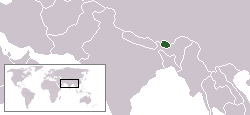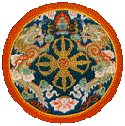Bhutan
|
|
The Kingdom of Bhutan is a small, landlocked nation of South Asia, located in the Himalaya Mountains, sandwiched between India and the People's Republic of China. The local name for the country, Druk Yul (pronounced dru ü), means "land of the dragon". It is also called Druk Tsendhen, "land of the thunder dragon", as the thunder there is said to be the sound of roaring dragons.
| |||||
| National motto: None | |||||

| |||||
| Official language | Dzongkha | ||||
| Capital | Thimphu | ||||
| King | Jigme Singye Wangchuk | ||||
| Prime Minister | Lyonpo Yeshey Zimba | ||||
| Area - Total - % water | Ranked 128th 47,000 km² Negligible | ||||
| Population - Total (2002) - Density | Density 2,094,176 45/km² | ||||
| Independence - Establishment | 1616 | ||||
| Currency | Ngultrum | ||||
| Time zone | UTC +6 | ||||
| National anthem | Druk tsendhen | ||||
| Internet TLD | .bt | ||||
| Calling Code | 975 | ||||
| Contents |
History
Main article: History of Bhutan
A Buddhist theocracy was established in Bhutan in the early 17th century.
In 1865, Britain and Bhutan signed the Treaty of Sinchulu, under which Bhutan would receive an annual subsidy in exchange for ceding some border land. Under British influence, a monarchy was set up in 1907; three years later, a treaty was signed whereby the British agreed not to interfere in Bhutanese internal affairs and Bhutan allowed Britain to direct its foreign affairs. This role was assumed by independent India after 1947. Two years later, a formal Indo-Bhutanese accord returned the areas of Bhutan annexed by the British, formalized the annual subsidies the country received, and defined India's responsibilities in defense and foreign relations.
A refugee issue of (reportedly) some 100,000 Bhutanese in Nepal remains unresolved; 90% of the refugees are housed in seven UNHCR camps. (see Main article: History of Bhutan for further details.)
Politics
Main article: Politics of Bhutan
The head of state is the King, or Druk Gyalpo, presently Jigme Singye Wangchuck. Although his title is hereditary, he can be removed by a two-thirds majority vote from the parliament, the unicameral National Assembly or Tshogdu. This body has 154 seats, and is composed of locally elected town representatives (105), religious representatives (12), and members nominated by the king (37), all of whom serve a three-year term.
Executive powers of the monarch were transferred to the council of ministers or cabinet (Lhengye Shungtsog) in 1998. Candidates to the council of ministers are nominated by the king, elected by the National Assembly, and serve fixed, five-year terms.
Government policies are framed around the core idea of preserving traditional culture and values. This has, however, generated some dissent from some southern Bhutanese of Nepalese descent (lhotsampa), who are reluctant to abide by the rules and regulations of the Buddhist majority.
Recently a new constitution consisting of a two party democratic system was unveiled after four years of preparation. This consititution is likely to be put up for ratification by a referendum at the end of the year 2005.
Districts
Bhutan is divided into 20 districts (dzongkhag, singular and plural):
- Bumthang
- Chukha (old spelling Chhukha)
- Dagana
- Gasa
- Haa
- Lhuntse (old spelling Lhuntshi)
- Mongar
- Paro
- Pemagatshel (old spelling Pemagatsel)
- Punakha
- Samdrup Jongkhar
- Samtse (old spelling Samchi)
- Sarpang
- Thimphu
- Trashigang (old spelling Tashigang)
- Trashiyangste
- Trongsa (old spelling Tongsa)
- Tsirang (old spelling Chirang)
- Wangdue Phodrang (old spelling Wangdi Phodrang)
- Zhemgang (old spelling Shemgang)
Geography
Main article: Geography of Bhutan
Bhutan is a very mountainous and landlocked nation, situated within the eastern Himalaya. Mountain peaks in the north reach up to over 7,000 meters, the highest point being the Kula Kangri at 7,553 meters. Gangkhar Puensum, at 7,541 meters, is the highest unclimbed mountain in the world. The southern part of the country has a lower altitude, and contains several fertile and densely forested valleys that flow down into the Brahmaputra river in India. Over 70% of the country is forested.
The majority of the population lives in the central highlands. The country's largest city, the capital Thimphu (population 50,000 [1] (http://www.smec.com.au/media/latest/bhutan.htm)), is located in the western part of these highlands. The local climate varies from tropical in the south to cool winters and hot summers in the central valleys, with severe winters and cool summers occurring in the Himalayas.
Economy
Main article: Economy of Bhutan
The economy, one of the world's smallest and least developed, is based on agriculture, forestry, and the sale of hydro-electric power to India (which is reported to supply 75% of government revenue). Agriculture, which provides the main livelihood for more than 90% of the population, consists largely of subsistence farming and animal husbandry. Rugged mountains dominate the terrain and make the building of roads and other infrastructure difficult and expensive. Incomes of over BTN100,000 per annum are taxed, but very few wage and salary earners qualify.
Bhutan's main economic partner is India, as its border with Tibet is closed. Bhutan's currency, the ngultrum, is interchangeable with the Indian Rupee. The industrial sector is minimal, with any production being of the cottage industry type. Most development projects, such as road construction, rely on Indian contract labour. Bhutan's hydropower potential and its attraction for tourists are key resources.
Model educational, social, and environmental programmes in Bhutan are underway, with support from multilateral development organisations, always taking Bhutan's wish for preservation of its traditions into account. The government has made some progress in expanding the nation's productive base and improving social welfare, though detailed controls and uncertain policies in many areas continue to hamper foreign investment. While major hydroelectric projects may lead to the expansion of the economy, many environmentalists fear the reprecussions of such projects upon the geography of the region.
Demographics
Main article: Demographics of Bhutan
About half of the population is composed of indigenous Bhutanese, known as the Ngalop, who are closely related to Tibetan tribes. Another major ethnic group is the Sharchop, also of Tibetan descent. They tend to be found mostly in the east of the country. The Lhotshampa, of Nepali descent, are economic immigrants from the 1950s. The majority of Nepalis are found in the southern districts of Bhutan. While Dzongkha is the official language, many local languages are spoken, with only a few fluent speakers of some in remote areas.
The official religion of Bhutan is the Mahayana tradition of Buddhism, which is adhered to by 75% of the population. A further 20-25% of the Bhutanese are Hindus.
Wheel_life_01.jpg
Culture
Main article: Culture of Bhutan
Bhutan is one of the most secluded nations in the world, and access for foreigners is restricted to certain areas, although these are expanding. The Kings of Bhutan prided themselves in keeping out foreign technological advancements like radio and television; a national broadcasting service has been in place since 1973, with television broadcasts only commencing in 1999.
Most of the population lives in small rural villages and supports itself through agriculture, growing crops or breeding yaks; urbanisation, however, is increasing. The Buddhist religion is an important part of life.
Universal health and education programmes were introduced by the third King, and all but the most remote villages have access to free medical care and primary education. Secondary education is available to all those who pass Class 8, with higher secondary education leading to tertiary studies for those who qualify in Class 10 examinations.
Trades and technical training are available at regional Vocational Training Institutes, with more advanced technical studies at the Royal Bhutan Institute of Technology near Phuentsholing. Degree studies are offered by Sherubtse College, Trashigang, or by the Royal Government in the form of overseas scholarships.
Archery is Bhutan's national sport, with traditional competitions being held regularly in most villages. Characteristic for the region is a type of fortress known as Dzong architecture.
In 2004, Bhutan became the first country in the world to ban public smoking entirely. Bhutanese citizens are still permitted to smoke within the confines of their home. The sale of tobacco has been prohibited, but individual citizens are allowed to import a certain quantity of cigarettes per year for their personal use. Foreigners are exempt from the non-smoking rule, although if they are caught selling tobacco products to residents they incur substantial fines.
See also
- List of Bhutan-related topics
- Music of Bhutan
- Communications in Bhutan
- Transportation in Bhutan
- Military of Bhutan
- Districts of Bhutan
- Foreign relations of Bhutan
External links
- Dept of Tourism (http://www.tourism.gov.bt/) - Official tourism bureau site
- Association of Bhutanese Tour Operators (http://www.abto.org.bt/) - Information on Tourism and listing of all Tour Operators from Bhutan.
- Journal of Bhutan Studies (http://www.bhutanstudies.org.bt) - Academic Research Papers on Bhutan
- BBS (http://www.bbs.com.bt) - Daily News Site from Bhutan (National radio and television)
- Kuenselonline (http://www.kuenselonline.com) - Daily News Site from Bhutan(National newspaper)
- administrative map of Bhutan (http://www.who.org.bt/AboutBhutan/AdmMap.htm)
- roadmap of Bhutan (http://www.nepaltravels.com/bhutan_map.htm)
- Bhutan on Wikitravel (http://wikitravel.org/en/Bhutan)
- UNICEF Adult Education Article (http://www.unicef.org/infobycountry/bhutan_25054.html)
- Keys to Bhutan (http://www.keystobhutan.com.com/), Organises exclusive privatre tours to Bhutan for people from all around the world. Lots of useful general information about Bhutan on their website.
- VAST Bhutan (http://www.vast-bhutan.org/), NGO using visual arts to work with kids.
- Fast forward into trouble (http://www.guardian.co.uk/weekend/story/0,3605,975769,00.html) An article by The Guardian about the terrible consequences of introducing television in this country in 1999.
| Countries in South Asia |
|---|
|
Bangladesh | Bhutan | India | Maldives | Nepal | Pakistan | Sri Lanka |
bg:Бутан (село) bn:ভূটান ca:Bhutan da:Bhutan de:Bhutan dz:འབྲུག་ཡུལ et:Bhutan es:Bután eo:Butano (lando) fr:Bhoutan he:בהוטן hi:भुतान id:Bhutan ia:Bhutan io:Bhutan lv:Butāna lt:Butanas ms:Bhutan nl:Bhutan ja:ブータン ko:부탄 no:Bhutan nds:Bhutan pl:Bhutan pt:Butão ru:Бутан (государство) sl:Butan (država) fi:Bhutan sv:Bhutan th:ประเทศภูฏาน zh:不丹



